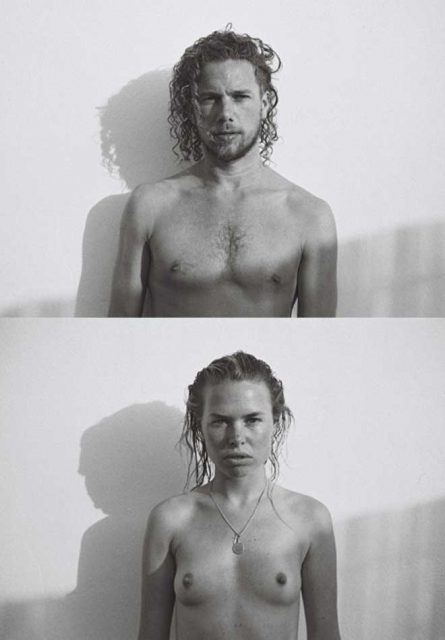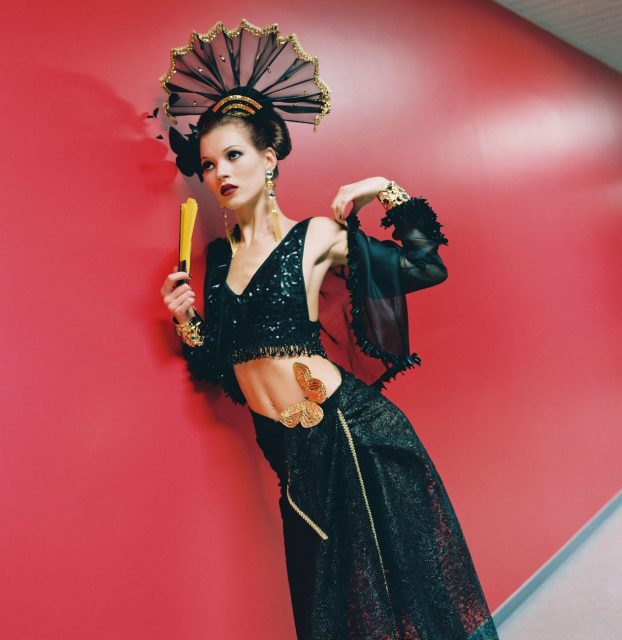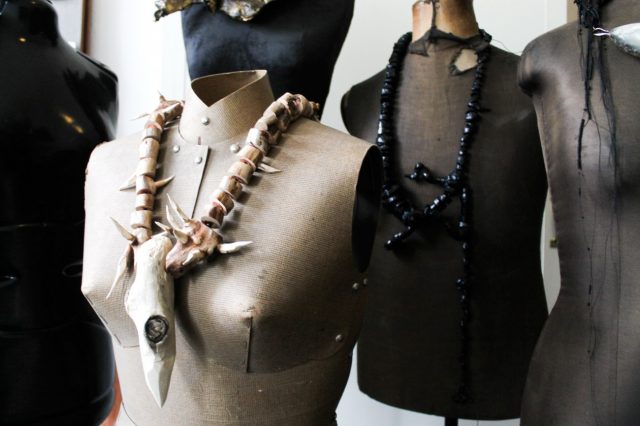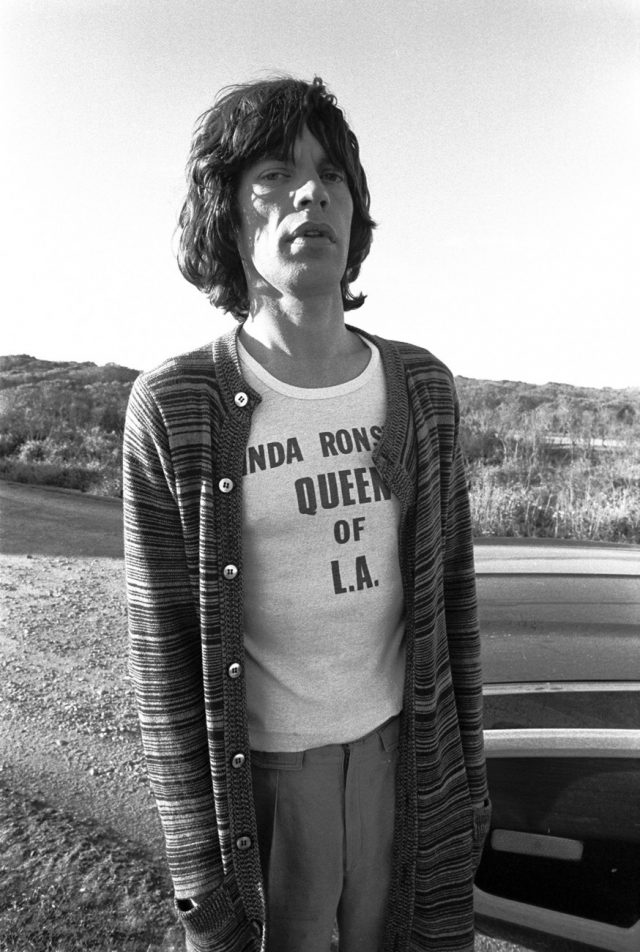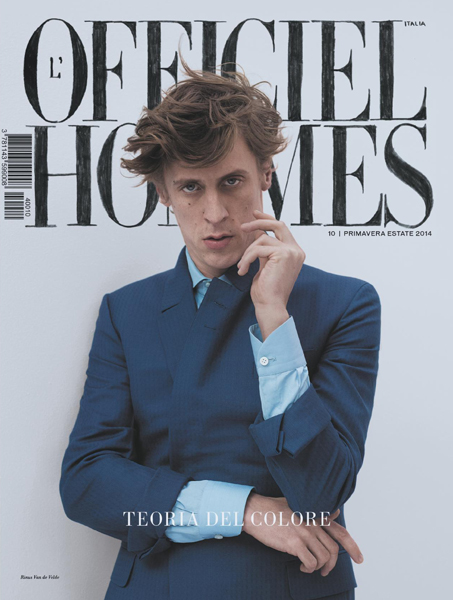
Rinus Van de Velde is known by art lovers and professionals all around the globe for his darkly romantic, narrative and exquisitely crafted charcoal drawings. Recently the Antwerp-based artist was introduced to the world of fashion, being featured on the cover of the renowned L’Officiel Homme Italia. This week he is in Berlin for his solo exhibition at the Galerie Zink, which started yesterday. We visited him a couple of hours before the big opening and got acquainted with a surprisingly calm Rinus in the magnificently modern and spacious gallery for a chat and a preview of his work.
People who do not know your work, might recognize you from the last cover of L’Officiel Homme Italia. How did that come about and how did you experience that?
R: I do not really know the world of fashion, but two collectors of my work, Willy Vanderperre and Olivier Rizzo, asked if they could take a picture of me for Vogue. They are nice guys, so I agreed and went to Paris to shoot. Since they are so wonderful, it was a pleasant experience, plus I really liked the result. I’m always curious for things I don’t know. I believe the people from L’Officiel saw that picture and then asked me if I could again come to Paris. Now the shoot would be combined with an article about my work and that I find much more important, instead of me being detached from my art. It was more out of curiosity that I went there and it was a day where you just constantly had to put on clothes, so actually rather boring. It was a nice team, but after a day I thought I had seen it all. In the end they asked if they could put the image on the cover, and why not? Since then other companies have asked me to feature in their campaign.
Who?
R: Quite recently Paul Smith asked me. It is a job that pays well and therefore I always agree since it buys me freedom to develop my art. It does not really interest me that much, but if the chance pops up -meaning that my work benefits from it- not having to look for subsidies, I kindly accept. It all comes back to my work and the job I have to do in return is quite easy. I think it is because I am an artist and nowadays some brands want to give their identity more creative cachet.
You make charcoal illustrations. Can I say illustrations or paintings?
R: They are actually more drawings. I try not to call it an illustration since that starts with words, while my work starts with an image and afterwards I attach the text. One could say it is illustrative, but an even better description would be narrative. You also can not really say paintings since there is a historical distinction with drawings. Paintings have always been the biggest medium, while drawings was always a preliminary study. Because drawing never was that big of a medium in art, there is a freedom that attracts me and in which I feel an artist can still discover a lot more.
Yes, charcoal drawings have indeed always been the by-product of an artwork. So what intrigues you in this particular art stream?
R: Because people think drawing is such an underwhelming style, it becomes much more interesting to get it at a level where it can become an autonomous piece of art. As a painter, you have to keep in mind a history of great, influential artists such as Rubens, Van Eijck and Richter. When drawing you do not have that heavy weight on your shoulders. Also, everyone has drawn in their life, but not everyone painted. It is the beginning of everything and makes this skill very light, easy and fast which attracts me. When you quickly draw something, you create a fictive world while trying to portray the real one. That is very identifiable to my work.
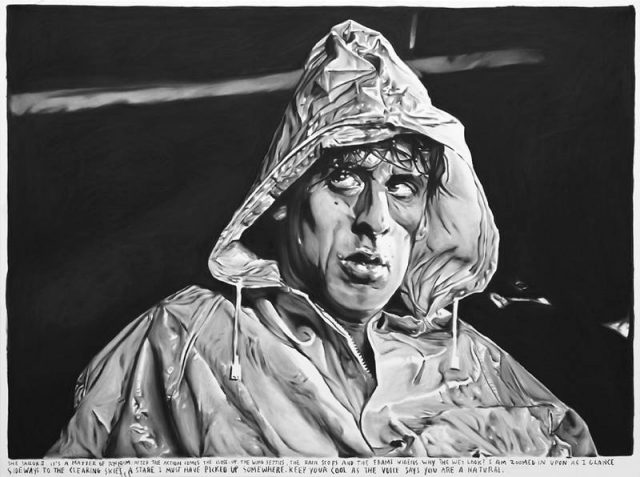
images courtesy of Zink Galerie
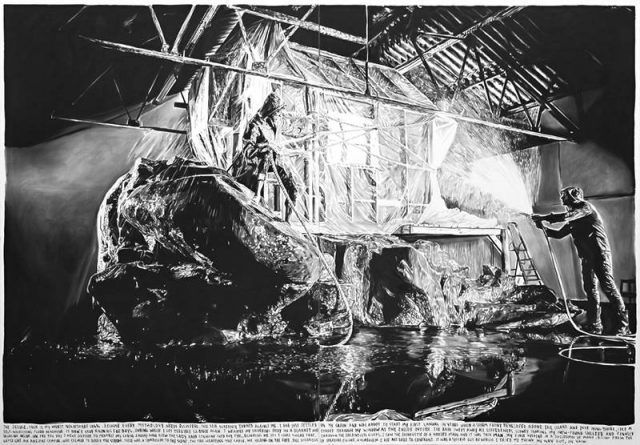
You place yourself as a protagonist in your work. Is that to show your personal life to the spectator or is more of an individual, imaginary trip?
R: Much more the second one. I am not trying to tell anything personal since I do not find that very interesting. Artists should always create for themselves, never for the spectators. Once you pay attention to that, you are making too many compromises and it will influence your work. For example, sometimes I find it surprising how many people do not read the text under my drawings, therefore I could leave them out, but I have to make my art in a way that is most convenient to me as an artist. I’m in the atelier every day, which is quite boring and therefore I just start coming up with stories in which I put myself. I just start to bring my fantasy to live.
So the drawings are solely based on your imagination?
R: No, I used to work with images I found in archives. Those I drew and then I pretended as if I was in that picture. Now I am making my own because then I have more control over the light. Those images are sketches for the end result. Obviously a part of the inspiration derives from certain photos or movies. It is all still connected to reality, otherwise the story would become like Lord of the Rings. Pure fantasy is never that interesting. You always need a relation to reality. I once made a series of drawings with a Russian poet Majakowski. He is a real person, but died a long time ago so you have an entrance to reality, but clearly know that what I am telling is not true.
You are based in Antwerp, but are here now in Berlin and have had your work in Spain, the Netherlands, Miami and many more places. How does it happen that a young artists like you breaks out of a rather small city onto the international art scene?
R: It depends. Here in Berlin, Galerie Zink discovered me, even though discovered is too big of a word, via another artist showing here who introduced my work. In most cases it is coincidence, but I do believe that if you work hard, eventually people will notice you. Certainly nowadays thanks to the internet spreading everything so fast.
Belgium is a good country to work in since it is so small and therefore you get noticed much quicker. Here in Berlin there are many more artists and therefore it must be harder to really stand out. People from all over the world also look at Antwerp, so if you stand out there, they will pick you up more easily.
You just mentioned everything spreading very fast nowadays. Do you still feel in control, because a lot of people experience this phenomenon as negative?
R: It is a sort of control that you have to let go or you will constantly live in some sort of fear. I feel there is still an old-fashioned view on social media and the internet. A lot of people still believe in a conservative model of only watching art in galleries, while the digital world has become one by itself now. Of course you will lose control, it is a wrong habit wanting to control everything. I sometimes come across publications where I wished I was not put in that context, but you have to cope with that. If you are afraid, you would say: ‘Okay, I want to be an integer type’, but something that just holds you back.
You told me before the interview you have been in Berlin quite a few times now. As an artist, what is your view on Berlin?
R: I do not come to Berlin as a tourist. I always go to the same places here. I try to watch as many exhibitions as possible and always hop in some book stores, since there are not that many in Antwerp. I actually do not really know Berlin, except for the few institutions I keep going back to. I find that pleasant. I am only here for a week and in a short amount of time, one can see many interesting shows here. I am always fascinated by how many young artists live here and then I wonder how they are able to get opportunities. I never felt like moving to such a creative, worldly city. It is nice to see something in Berlin or to go to London for a good exhibition, but that does not mean I have to live there. Antwerp is perfect in its smallness. I know where everything is, it is not far, it is really cheap to have a big atelier there.
Would it have held you back starting in Berlin as a young artist?
R: I would be too distracted by all those exhibitions. Sometimes it is good to live in isolation when you are working, so you can base everything on your thoughts being translated into your work. Of course it is inspiring to look at other people’s art, but at the same time it can be super confusing. The best exhibition messes with you. Sometimes that is hard to take into your own atelier. I would very quickly visit everything in Berlin, but therefore create less myself.
The exhibition that you have here in the Galerie Zink is about an artist looking for the perfect work and all the struggles that come with that quest. Is there no translation from your own experiences into this work?
R: The drawings are about an artist. It is a fictive autobiography so there are connections to reality, but those are issues that interest me. Therefore I think about them and draw them. It is a very romantic story, a guy who arrives at a desolated island, builds his home on the rocks and tries to create something in complete isolation, during which he gets a bit psychotic. That I will never experience myself, because I would never isolate myself. I’m a social being. It is actually a representation of everything I am not. That is why I am an adventurer in my work since I don’t really do that in real life. I like to be in my atelier, so I have the chance to think about that in my work, creating a story of what I would do when in that situation. Like the Majakowski work, it asks, “How would I react to living in the beginning of the 20th century in Russia during the October revolution?” There is a romantic side to the story, with the artist as the divine creator, searching for his masterpiece. I find it pleasant to think about how it would be if I where in that position. It is really difficult to think about a contemporary context, art is so splintered so there is not an art stream anymore, making it hard to position yourself in the industry. That is why looking back to times when everything was still identifiable is so interesting.
When you draw, construct and make up these stories. To what extend can you still distinct them from reality? How far do you go into that imaginary world?
R: I am never completely in the story. Practically I am on a rock, well-lit and standing still. It is not like an actor. Nevertheless, I am building the construction so I do get confronted with a sort of physical reality. In a lot of the drawings, it is raining in the stor, yet in actuality,ba friend of mine is spraying water on me with a hose. I really feel the water in your face and it is really cold. Yet another in-between situation. I feel the same cold and wetness as in the imaginative world, while still being in the safe environment of my atelier. Sometimes in nursing homes for the elderly, they put bus stops on the premises. That is because elderly people can have escape tendencies. They just sit at the stop, see there is no bus coming, the urge disappears and then they go back in. It is through the act of sitting at a the construction that your wish or need is fulfilled and you are able to go back to your normal environment. Maybe for me, I wish to be in this hut on that island, but I just feel the need for a short amount of time. I do not need to go there for real. That is just too cumbersome and I am too scared for that.
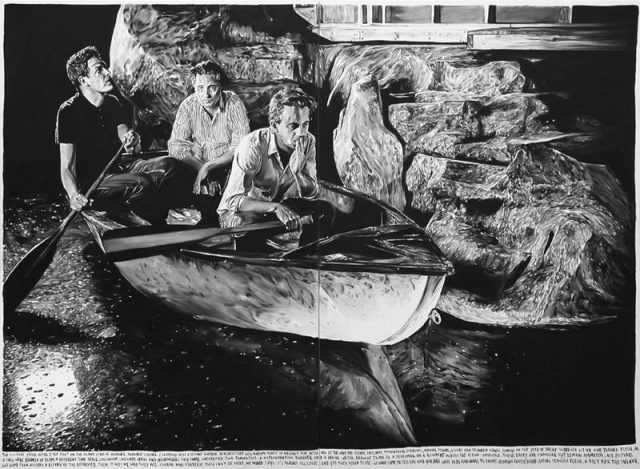
images courtesy of Zink Galerie

The installation is complemented by a construction enforcing the drawings. Do you feel that is necessary? Is it a purely functional thing to drag the people into the story?
R: Before I thought it was all about the drawings since that is the final product, but people could then get the feeling that you were actually present at the location. Therefore I now wanted to make a construction that is in between a décor and a sculpture at which you can look and see the relation with the drawings. The construction then becomes a remnant of the scenery.
So the installation is not to drag people into the story, but to make it clear to them that it is a constructed reality?
R: Exactly. I also find that an exhibition with only artwork on the walls always leaves a horrible whole in the middle of the space. I just wanted something to happen there. I studied sculpture and for a while now I’ve felt the need to have something physical. What I also like is the uselessness of the construction. I build something for such a long time, only to then draw it. I find it necessary to show, because it is such a big part of the work. I cannot draw blindly, so I have to rebuild everything myself before the process of drawing, which makes the build-up utterly fundamental. By now, it is almost as important as the drawings and therefore important to showcase.
You always use black and white hues, which gives an impression of solitude, yet nostalgia and romance at the same time. Is that what you want for every of your works?
R: There is a sense of romance and documentary in my art, it being a document of a life I never had. That makes the term nostalgic quite logical. I step outside of my own body and then look at myself, implying some sort of past tense. The black and white colors seem natural since I am working with documents from archives. Other than that is there also a practical explanation: I cannot draw in color. Working with such formats is really difficult and I have never witnessed a beautiful, colored work of that scale. I cannot spend too much time trying to find the right colors. I love to use this one black charcoal stick without any other colors. That would cause distraction. Now I just focus on the image and not on what color I would use for it. It just creates uniformity necessary when you make several works about one and the same story.
What’s after this exhibition?
R: It is always about finding the right balance to get your schedule really full while still keep it empty enough to find time to experiment with new stuff. I worked on this exhibition for half a year, then I show it and afterwards I have a couple of weeks trying to look for a new path to enter. Then I feel my ideas splintering and different possibilities come up, but after a while I need a new exhibition to focus again and be forced to opt for one path, sticking to that certain idea. Next up is something for the Tim Van Laere gallery in Antwerp for next September. Therefore I am making the décor right now. It will not be an exterior construction, but something you really walk into. I rebuild the space from the gallery a bit smaller in my own atelier and am building an apartment in which the pieces will be showcased. Then I will move the interior to the gallery, so people walk into the gallery and then they enter my space, a completely different environment. For this exhibition in Berlin, I feel there is still a distance between the visitors and the construction, but next time they will really have to walk into it and be involved. You can only know those kind of things after an exhibition. Every time you learn from it a push yourself.
Some call you a rising star. How do you feel about that?
R: You do not have to spend too much time listening to that. It feels flattering for a couple of seconds, but then you have to get back to your work. That sort of confirmation is not good for an artist, the only drive should be his work. The pats on the shoulder should not be the motivation. If you only work based on those compliments or on the boost you get, you will crash and burn at one point. There will be a time when you will not be the rising star anymore while still being able to continue doing what you do. Nevertheless I am always kind of sensitive to critics, for sure the negative ones, but I learned to cope with that. You cannot please everyone with your work. People can put my work in perspective, but I never will do that myself. To me my work is the most important thing there is. I one hundred percent believe in my work, which is very important because if I do not believe then who will.

image courtesy of Zink Galerie
Rinus’ exhibition can be visited in the Zink Galerie until the 8th of November.
